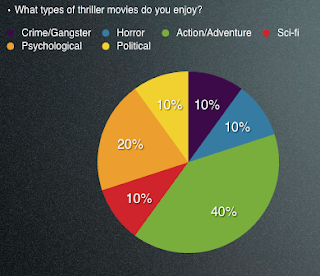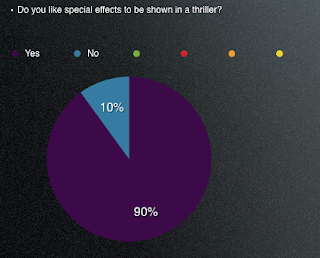Opening Sequence Analysis
Panic Room
Camera Shot/Angle/Movement
Different shots are used in the opening scene when the names appear in the air in front of various locations in New York city. The establishing shot shows a town with a river between it, but we discover it is New York with the other shots. Most of the other shots are omniscient shots when they are looking down at buildings or panning shots when they show different parts of New York with the names of the actors in front of the scenery. The different shots keeps the audience interested on the film.
Sound
The music in the opening scene is non-diegetic. You can hear diegetic sounds in the background such as police sirens and car horns, which is realistic in New York city. The pace of the non-diegetic sound, which is an orchestra of violins and other instruments like drums, quickens and the sound of a clock ticking adds to the speed of the pace as they go together in unison. This creates a feeling to the audience of tension and this build-up of sound maintains their interest.
Editing
The editing of the opening scene gives a sense to the viewer that this is a thriller. The names of people appear in different parts of New York as the scene and music progresses. The cuts are all in similar length to display the shots of New York and the names so it plays in time with the non-diagetic sound.
Mise en Scene
The special effects used are the names that appear in the air in different areas of New York city. The words appear in long, establishing and omniscient shots to keep the viewer’s interest.
Characters
No characters are shown or established in the opening scene. Although no idea of characters in the film are portrayed, famous Hollywood stars such as Jodie Foster and Forest Whitaker, so many people may want to watch the film.
Locations
New York city is established through the different shots in the opening scene; areas such as Central Park in a long shot and Times Square in a still shot.
Narrative/Plot
There is no obvious plot given through the opening scene because it consists of just shots of New York, so we are only given information about location.
Themes
The opening sequence suggests that the film is most likely a thriller film because of the title Panic Room which echoes the type of feelings that the main characters have in the film and that the quickening ticking sound is conventional in a thriller when something sudden happens.
Visual Style
The opening scene is quite similar to a conventional thriller opening. It uses special effects for the names of the actors and the film company. We cannot judge characters in the scene because no-one is portrayed yet in the film.
Genre
The opening sequence of Panic Room suggests that the film is of a thriller genre because you get a sense of the sound, which is fast and loud, so it tells the audience that something dramatic will happen and that the title suggests feelings of panic and drama will occur.
Camera Shot/Angle/Movement
Sound
The music is intense and creepy with a lot of sharp and disturbing sounds; creating a rather uncomfortable and tense atmosphere. There are also sounds which can be related to the screaming of another being.
Editing
There are flashes from one image to another, and distorted writing appears across the screen. We also get a very quick glimpse of a droplet of what is assumed to be blood. The way this is edited is very effective as it all links together smoothly.
Mise en Scene
There is little lighting except for the use of capturing shadows, this is perhaps done to reflect the dull surroundings of a typical killer. We do not get much of an idea as to the set, but the props include odd tools, photographs of murdered victims and highlighted texts - this gets the audience thinking.
Characters
There is no introduction to characters, just close-ups of a pair of hands, belonging to the ambiguous character. We are encouraged to assume the hands belong to that of a criminal, perhaps trying to cover any evidence of finger- prints, as we see the removal of skin from the fingertips. It is also hinted at that the character is involved in murders, and perhaps planning more, since we are shown flashes of disturbing photographs of people. We are given clues to the character but do not actually hear voices or see any faces in the clip.
Locations
The camera focuses on objects, rather than surroundings - the setting is left to our imagination; all we know is that the location is dark, with shadows, and creates a tense and creepy atmosphere.
Narrative/Plot
There is no dialogue or introduction to characters or setting, so the story line is left to our imaginations at this point. We do however see violent images in the opening credits so we are left to assume the story will involve murder and violence.
Themes
Although we are not told what the themes are, they are simply hinted at in the first clip of the film. Due to the violent imagery presented in the form of photography, themes suggested include pain, suffering, horrific deaths, murder and a psychopathic killer.
Visual Style
The visual style of this film (based on the opening credits) is quite unique in that the credits appear as though they are hand written. They appear in flashes, in quite an erratic way, as though to portray the erratic mind of the killer.
Genre
After hints to the story in the opening credits, we are aware that we are watching a thriller or horror movie. This is done thorough sound, editing, typography of text or credits and violent imagery. There is also an idea of suspense, linking to the ideal aspects of a thriller.
Comparison of Panic Room and Se7en
Camera Shot/Angle/Movement
Panic Room differs greatly to Se7en in terms of camera shots because it uses a lot of shots whilst the names appear in the air in front of various locations in New York City. The establishing shot of Panic Room shows a town with a river in between, so at first it isn’t obvious. Most of the other shots are omniscient shots looking down at buildings and panning across the imagery of New York. However Se7en has more close-up shots and is inside not outside, so the shots show everyday things such as books and writing. The shots are quick and convey a mysterious setting for the audience so we are supposed to feel unease. This method builds tension and sets the tone for the films, meanwhile the opening for Panic Room keeps the audiences interest of New York.
Sound
The sound for Se7en is non-diegetic (background music) which is the same for Panic Room, however diegetic sounds in Panic Room are heard in the background such as police sirens and car horns, which is realistic in New York. They are also similar because both of the sounds from both films increases in pace to maintain the audiences interest and appear in unison with objects that appear on the screen for example, when the razor appears in Se7en a static dark sound is heard. The sounds may be different, as Se7en uses dark and eery sounds and Panic Room uses normal instruments like violins and drums, but they achieve the same effect - to build tension through the first scene.
Editing
The opening to Panic Room gives a sense to the viewer that it is of a thriller genre. The names of people appear in different parts of New York as the sense and music progresses. The various shots are in similar length to display shots of New York and the names so it plays in time with the non-diegetic sound. This is quite similar to Se7en as the music progresses which gives us more of a sense of a thriller, however it is different because the sound appears in unison with the objects that appear on the screen, which may not be made by these actual objects but can be related to them.
Mise-en-scene
Special effects used in Se7en are minimal because the actors names flash on the screen quickly and appear more than once or have a mirrored effect or fade out. The words appear to have been hand written, opposed to the conventions of computing stylings. This is different to Panic Room as the special effects appearing in different areas of New York are shown in establishing and omniscient shots to keep the viewers interest.
Characters
No characters are shown or established during the opening scene of Panic Room and no idea of characters are portrayed, only the Hollywood names that appear, so many people may want to watch the film. This is the same for Se7en because the character in the first scene is shown cutting his fingers and developing photos, but we cannot see his face. This shows the character to be possibly anti-social which is conventional of a detective/crime film. This differs to the fact that the opening to Panic Room is all outside; Se7en is all inside.
Locations
The location is unclear for Se7en because more attention is payed to the things that the character is doing, highlighting his character as disturbed, which is different for Panic Room because New York City is established through the different such as Central Park in a long shot and Times Square in a still shot.
Narrative
There is no obvious plot given through to the opening scene of Panic Room, as it consists mainly of shots of New York and so we are only given information about location. This contrasts to Se7en because although there is no narrative as well, the things that the man is doing suggests that he is most likely to murder or torture someone because it is conventional to his character. The title is vague to the audience because we do not know the significance of seven to the rest of the film.
Themes
The opening to Se7en shows the audience that it is most likely of a horror/thriller theme because of the things that the main character does - conventional to the characteristics of a thriller movie. This is similar to the opening of Panic Room because the title echoes the feeling that the main characters might have in the film, and the quickening ticking sound furthers this thought, as if something sudden will happen.






















